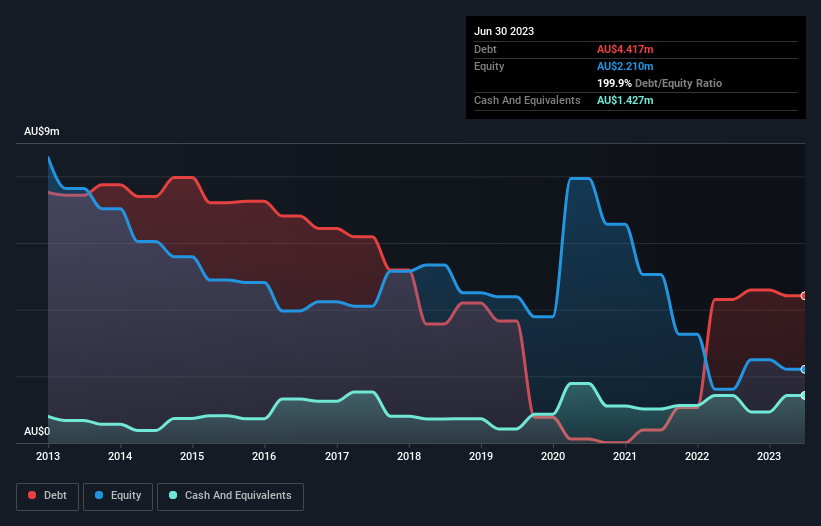David Iben put it well when he said, 'Volatility is not a risk we care about. What we care about is avoiding the permanent loss of capital.' It's only natural to consider a company's balance sheet when you examine how risky it is, since debt is often involved when a business collapses. As with many other companies Oldfields Holdings Limited (ASX:OLH) makes use of debt. But is this debt a concern to shareholders?
When Is Debt A Problem?
Debt and other liabilities become risky for a business when it cannot easily fulfill those obligations, either with free cash flow or by raising capital at an attractive price. Part and parcel of capitalism is the process of 'creative destruction' where failed businesses are mercilessly liquidated by their bankers. While that is not too common, we often do see indebted companies permanently diluting shareholders because lenders force them to raise capital at a distressed price. Of course, debt can be an important tool in businesses, particularly capital heavy businesses. The first step when considering a company's debt levels is to consider its cash and debt together.
View our latest analysis for Oldfields Holdings
What Is Oldfields Holdings's Net Debt?
The chart below, which you can click on for greater detail, shows that Oldfields Holdings had AU$4.42m in debt in June 2023; about the same as the year before. On the flip side, it has AU$1.43m in cash leading to net debt of about AU$2.99m.

A Look At Oldfields Holdings' Liabilities
The latest balance sheet data shows that Oldfields Holdings had liabilities of AU$13.8m due within a year, and liabilities of AU$5.20m falling due after that. Offsetting this, it had AU$1.43m in cash and AU$6.55m in receivables that were due within 12 months. So its liabilities total AU$11.1m more than the combination of its cash and short-term receivables.
Given this deficit is actually higher than the company's market capitalization of AU$7.99m, we think shareholders really should watch Oldfields Holdings's debt levels, like a parent watching their child ride a bike for the first time. Hypothetically, extremely heavy dilution would be required if the company were forced to pay down its liabilities by raising capital at the current share price. When analysing debt levels, the balance sheet is the obvious place to start. But it is Oldfields Holdings's earnings that will influence how the balance sheet holds up in the future. So when considering debt, it's definitely worth looking at the earnings trend. Click here for an interactive snapshot.
In the last year Oldfields Holdings wasn't profitable at an EBIT level, but managed to grow its revenue by 54%, to AU$38m. With any luck the company will be able to grow its way to profitability.
Caveat Emptor
While we can certainly appreciate Oldfields Holdings's revenue growth, its earnings before interest and tax (EBIT) loss is not ideal. Its EBIT loss was a whopping AU$1.2m. Considering that alongside the liabilities mentioned above make us nervous about the company. We'd want to see some strong near-term improvements before getting too interested in the stock. Not least because it had negative free cash flow of AU$714k over the last twelve months. That means it's on the risky side of things. When analysing debt levels, the balance sheet is the obvious place to start. But ultimately, every company can contain risks that exist outside of the balance sheet. For example Oldfields Holdings has 4 warning signs (and 3 which are a bit concerning) we think you should know about.
Of course, if you're the type of investor who prefers buying stocks without the burden of debt, then don't hesitate to discover our exclusive list of net cash growth stocks, today.
New: AI Stock Screener & Alerts
Our new AI Stock Screener scans the market every day to uncover opportunities.
• Dividend Powerhouses (3%+ Yield)
• Undervalued Small Caps with Insider Buying
• High growth Tech and AI Companies
Or build your own from over 50 metrics.
Have feedback on this article? Concerned about the content? Get in touch with us directly. Alternatively, email editorial-team (at) simplywallst.com.
This article by Simply Wall St is general in nature. We provide commentary based on historical data and analyst forecasts only using an unbiased methodology and our articles are not intended to be financial advice. It does not constitute a recommendation to buy or sell any stock, and does not take account of your objectives, or your financial situation. We aim to bring you long-term focused analysis driven by fundamental data. Note that our analysis may not factor in the latest price-sensitive company announcements or qualitative material. Simply Wall St has no position in any stocks mentioned.
About ASX:OLH
Oldfields Holdings
Engages in the provision of scaffolding and painting accessories in Australia, New Zealand, and internationally.
Medium-low risk and slightly overvalued.
Market Insights
Community Narratives



